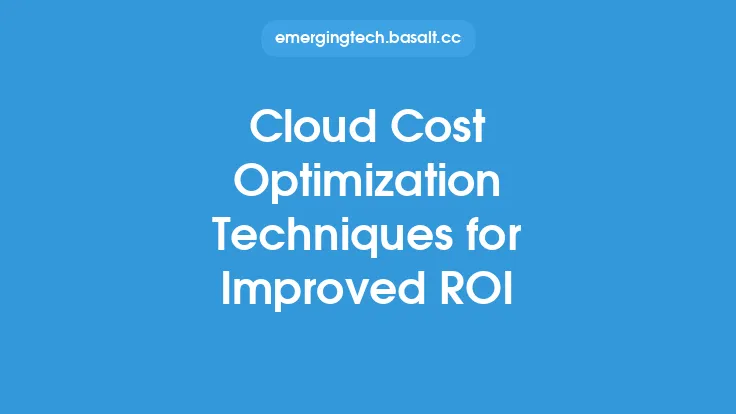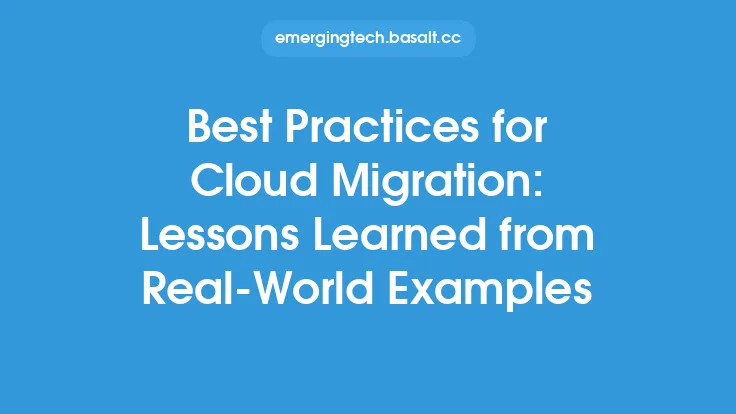As enterprises continue to migrate their workloads to the cloud, managing and optimizing cloud costs has become a critical aspect of their overall IT strategy. With the increasing complexity of cloud environments and the rapid pace of innovation, it's essential for organizations to have the right tools in place to ensure they're getting the most out of their cloud investments. In this article, we'll explore the top cloud cost optimization tools for enterprises, highlighting their key features, benefits, and use cases.
Introduction to Cloud Cost Optimization Tools
Cloud cost optimization tools are designed to help enterprises manage and reduce their cloud expenses by providing visibility into usage patterns, identifying areas of waste, and optimizing resource allocation. These tools can be categorized into several types, including cost monitoring and analytics, resource optimization, and cloud management platforms. By leveraging these tools, organizations can gain a deeper understanding of their cloud costs, make data-driven decisions, and improve their overall return on investment (ROI).
Key Features of Cloud Cost Optimization Tools
When evaluating cloud cost optimization tools, there are several key features to consider. These include:
- Cost monitoring and analytics: The ability to track and analyze cloud usage and costs in real-time, providing detailed insights into spending patterns and trends.
- Resource optimization: The ability to identify underutilized or unused resources, such as virtual machines, storage, and databases, and provide recommendations for rightsizing or terminating them.
- Automated scaling and scheduling: The ability to automatically scale resources up or down based on demand, and schedule resources to run only when needed.
- Reserved instance management: The ability to manage and optimize reserved instances, including purchasing, renewing, and exchanging them.
- Cloud provider integration: The ability to integrate with multiple cloud providers, including Amazon Web Services (AWS), Microsoft Azure, Google Cloud Platform (GCP), and IBM Cloud.
Top Cloud Cost Optimization Tools for Enterprises
Some of the top cloud cost optimization tools for enterprises include:
- AWS CloudWatch: A monitoring and analytics service that provides detailed insights into AWS usage and costs.
- Azure Cost Estimator: A tool that helps estimate and manage Azure costs, including providing recommendations for optimizing resource allocation.
- Google Cloud Cost Estimator: A tool that helps estimate and manage GCP costs, including providing recommendations for optimizing resource allocation.
- ParkMyCloud: A cloud management platform that provides automated scaling and scheduling, reserved instance management, and cost monitoring and analytics.
- Turbonomic: A cloud management platform that provides real-time monitoring and analytics, automated scaling and scheduling, and reserved instance management.
- Cloudability: A cloud cost management platform that provides detailed insights into cloud usage and costs, including providing recommendations for optimizing resource allocation.
- Apptio: A cloud-based application that provides detailed insights into IT costs, including cloud costs, and helps organizations optimize their IT investments.
Benefits of Using Cloud Cost Optimization Tools
The benefits of using cloud cost optimization tools include:
- Cost savings: By identifying areas of waste and optimizing resource allocation, organizations can reduce their cloud costs and improve their ROI.
- Improved visibility: Cloud cost optimization tools provide detailed insights into cloud usage and costs, helping organizations make data-driven decisions.
- Increased efficiency: By automating scaling and scheduling, and optimizing resource allocation, organizations can improve the efficiency of their cloud environments.
- Better decision-making: Cloud cost optimization tools provide organizations with the data and insights they need to make informed decisions about their cloud investments.
Best Practices for Implementing Cloud Cost Optimization Tools
When implementing cloud cost optimization tools, there are several best practices to keep in mind. These include:
- Start with a thorough assessment: Begin by assessing your current cloud environment and identifying areas for optimization.
- Set clear goals and objectives: Define what you want to achieve with your cloud cost optimization efforts, and set clear goals and objectives.
- Choose the right tools: Select cloud cost optimization tools that align with your goals and objectives, and provide the features and functionality you need.
- Monitor and analyze usage: Continuously monitor and analyze your cloud usage and costs, and make adjustments as needed.
- Optimize and refine: Continuously optimize and refine your cloud environment, including rightsizing resources, terminating unused resources, and optimizing reserved instances.
Conclusion
Cloud cost optimization tools are essential for enterprises looking to manage and optimize their cloud costs. By providing visibility into usage patterns, identifying areas of waste, and optimizing resource allocation, these tools can help organizations reduce their cloud expenses and improve their ROI. When evaluating cloud cost optimization tools, consider key features such as cost monitoring and analytics, resource optimization, and cloud provider integration. By following best practices and leveraging the right tools, organizations can achieve significant cost savings, improve efficiency, and make better decisions about their cloud investments.





